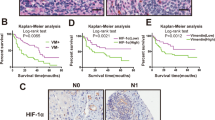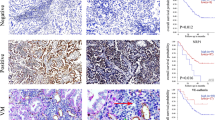Abstract
Background
Vasculogenic mimicry (VM), an alternative microvascular circulation independent of angiogenesis, is formed by aggressive cancer cells. Tumor-expressed B7-H3 has been reported to promote VM formation in hepatocellular carcinoma and modulate angiogenesis in breast cancer and colorectal cancer. However, its effects on VM generation and angiogenesis in non-small cell Lung cancer (NSCLC) remained to be elucidated.
Methods
CRISPR/Cas9-mediated B7-H3 knockout (KO) was conducted in NSCLC A549 and H3255 cells. The expression of VM-related proteins, including vascular endothelial (VE)-cadherin and matrix metalloproteinase 14 (MMP14), and the secretion of vascular endothelial growth factor (VEGF) were measured by western blotting and chemiluminescence assay in both B7-H3 KO and mock-edited A549 and H3255 cells. To examine VM formation, a three-dimensional (3D) culture model was used for B7-H3 KO and mock A549 and H3255 cells. For in vivo analysis, xenograft mice models were established using B7-H3 KO and mock-edited A549 cells, and immunohistochemical (CD31) and histochemical (periodic acid-Schiff, PAS) double staining were performed to identify VM and endothelial vessels in tumor tissues. Finally, specific signaling inhibitors were used to analyze B7-H3-induced signaling pathway responsible for VE-cadherin and MMP14 expression and VM generation.
Results
Higher expression of B7-H3 was associated with a worse prognosis and more advanced T-category in NSCLC. CRISPR/Cas9-mediated B7-H3 KO in A549 and H3255 cells led to decreased expression of VE-cadherin and MMP14; however, the secretion of VEGF by the two cell lines remained unchanged. In the 3D cell culture model, both B7-H3 KO A549 and H3255 cells showed a significant reduction in the formation of capillary-like tubular structures compared to mock-edited cells. In the in vivo xenograft model, mock-edited A549 cells formed excessive PAS+ CD31− VM channels, while B7-H3 KO restrained VM formation in the xenograft tumors. However, no significant differences were found in CD31+ endothelial vessels between xenografts formed by B7-H3 KO and mock-edited A549 cells. Finally, we analyzed the signaling pathway responsible for B7-H3-induced VM formation and found that selective inhibition of the phosphoinositide 3-kinase(PI3K)/protein kinase B (AKT) hyperactivation by LY294002 was associated with decreased expression of MMP14 and VE-cadherin, and in vitro VM formation by both A549 and H3255 cells.
Conclusions
Tumor-expressed B7-H3 acts via PI3K/AKT signaling pathway to promote VM formation by NSCLC cells while bears no effects on angiogenesis in NSCLC.








Similar content being viewed by others
Data availability
The datasets supporting the conclusions of this article are included within the article and its additional file.
References
Altan M et al (2017) B7–H3 expression in NSCLC and Its association with B7–H4, PD-L1 and tumor-infiltrating lymphocytes. Clin Cancer Res 23(17):5202–5209
Andonegui-Elguera MA et al (2020) An overview of vasculogenic mimicry in breast cancer. Front Oncol 10:220
Campinho P, Vilfan A, Vermot J (2020) Blood flow forces in shaping the vascular system: a focus on endothelial cell behavior. Front Physiol 11:552
Chen Z et al (2014) Non-small-cell lung cancers: a heterogeneous set of diseases. Nat Rev Cancer 14(8):535–546
Cheng R et al (2020) CD276 promotes vasculogenic mimicry formation in hepatocellular carcinoma via the PI3K/AKT/MMPs pathway. Oncol Targets Ther 13:11485–11498
Cheng N et al (2021) B7-H3 augments the pro-angiogenic function of tumor-associated macrophages and acts as a novel adjuvant target for triple-negative breast cancer therapy. Biochem Pharmacol 183:114298
de la Cruz ONH et al (2020) Regulation networks driving vasculogenic mimicry in solid tumors. Front Oncol 9:1419
Delgado-Bellido D et al (2017) Vasculogenic mimicry signaling revisited: focus on non-vascular VE-cadherin. Mol Cancer 16(1):65
Ding M et al (2020) B7-H3-induced signaling in lung adenocarcinoma cell lines with divergent epidermal growth factor receptor mutation patterns. Biomed Res Int 2020:8824805
Fernandez-Cortes M, Delgado-Bellido D, Oliver FJ (2019) Vasculogenic mimicry: become an endothelial cell “But Not So Much”. Front Oncol 9:803
Hess AR et al (2003) Phosphoinositide 3-kinase regulates membrane Type 1-matrix metalloproteinase (MMP) and MMP-2 activity during melanoma cell vasculogenic mimicry. Cancer Res 63(16):4757–4762
Hirsch FR et al (2017) Lung cancer: current therapies and new targeted treatments. Lancet 389(10066):299–311
Janakiram M et al (2017) The third group of the B7-CD28 immune checkpoint family: HHLA2, TMIGD2, B7x, and B7–H3. Immunol Rev 276(1):26–39
Kang FB et al (2015) B7–H3 promotes aggression and invasion of hepatocellular carcinoma by targeting epithelial-to-mesenchymal transition via JAK2/STAT3/Slug signaling pathway. Cancer Cell Int 15:45
Kheradmand F, Rishi K, Werb Z (2002) Signaling through the EGF receptor controls lung morphogenesis in part by regulating MT1-MMP-mediated activation of gelatinase A/MMP2. J Cell Sci 115(Pt 4):839–848
Kontos F et al (2021) B7–H3: an attractive target for antibody-based immunotherapy. Clin Cancer Res 27(5):1227–1235
Lai HJ et al (2019) B7–H3 modulates endothelial cell angiogenesis through the VEGF cytokine. Immunol Res 67(2–3):202–211
Lamouille S, Xu J, Derynck R (2014) Molecular mechanisms of epithelial-mesenchymal transition. Nat Rev Mol Cell Biol 15(3):178–196
Li Z et al (2019) The immunoregulatory protein B7–H3 promotes aerobic glycolysis in oral squamous carcinoma via PI3K/Akt/mTOR pathway. J Cancer 10(23):5770–5784
Li H et al (2021a) SUMOylation of IGF2BP2 promotes vasculogenic mimicry of glioma via regulating OIP5-AS1/miR-495-3p axis. Int J Biol Sci 17(11):2912–2930
Li M et al (2021b) Immune infiltration of MMP14 in pan cancer and its prognostic effect on tumors. Front Oncol 11:717606
Liao HX et al (2022) B7-H3 promotes the epithelial-mesenchymal transition of NSCLC by targeting SIRT1 through the PI3K/AKT pathway. Mol Med Rep 25(3):79
Lim D et al (2020) Angiogenesis and vasculogenic mimicry as therapeutic targets in ovarian cancer. BMB Rep 53(6):291–298
Lin L et al (2019) B7–H3 promotes multiple myeloma cell survival and proliferation by ROS-dependent activation of Src/STAT3 and c-Cbl-mediated degradation of SOCS3. Leukemia 33(6):1475–1486
Liu TJ et al (2013) CD133+ cells with cancer stem cell characteristics associates with vasculogenic mimicry in triple-negative breast cancer. Oncogene 32(5):544–553
Liu K et al (2015) Hypoxia promotes vasculogenic mimicry formation by the Twist1-Bmi1 connection in hepatocellular carcinoma. Int J Mol Med 36(3):783–791
Mani SA et al (2008) The epithelial-mesenchymal transition generates cells with properties of stem cells. Cell 133(4):704–715
Maniotis AJ et al (1999) Vascular channel formation by human melanoma cells in vivo and in vitro: vasculogenic mimicry. Am J Pathol 155(3):739–752
Meng J et al (2019) Hsp90beta promotes aggressive vasculogenic mimicry via epithelial-mesenchymal transition in hepatocellular carcinoma. Oncogene 38(2):228–243
Poincloux R et al (2011) Contractility of the cell rear drives invasion of breast tumor cells in 3D Matrigel. Proc Natl Acad Sci U S A 108(5):1943–1948
Ribatti D (2019) The discovery of the fundamental role of VEGF in the development of the vascular system. Mech Dev 160:103579
Schnegg CI et al (2015) Induction of vasculogenic mimicry overrides VEGF-A silencing and enriches stem-like cancer cells in melanoma. Cancer Res 75(8):1682–1690
Shi J et al (2021) CD276 (B7H3) improve cancer stem cells formation in cervical carcinoma cell lines. Transl Cancer Res 10(1):65–72
Son Y, Kwon SM, Cho JY (2019) CD276 (B7–H3) maintains proliferation and regulates differentiation in angiogenic function in late endothelial progenitor cells. Stem Cells 37(3):382–394
Sun J et al (2014) B7–H3 expression in breast cancer and upregulation of VEGF through gene silence. Onco Targets Ther 7:1979–1986
Sung H et al (2021) Global Cancer Statistics 2020: GLOBOCAN Estimates of Incidence and Mortality Worldwide for 36 Cancers in 185 Countries. CA Cancer J Clin 71(3):209–249
Tang Z et al (2017) GEPIA: a web server for cancer and normal gene expression profiling and interactive analyses. Nucleic Acids Res 45(W1):W98–W102
Tian F et al (2021) Noninvasive bioluminescence imaging of matrix metalloproteinase-14 activity in lung cancer using a membrane-bound biosensor. Anal Chem 93(25):8739–8745
Uhlen M et al (2015) Proteomics. Tissue-based map of the human proteome. Science 347(6220):1260419
Uhlen M et al (2017) A pathology atlas of the human cancer transcriptome. Science 357(6352):eaan2507
Walters S et al (2013) Lung cancer survival and stage at diagnosis in Australia, Canada, Denmark, Norway, Sweden and the UK: a population-based study, 2004–2007. Thorax 68(6):551–564
Wang HF et al (2019) Hypoxia promotes vasculogenic mimicry formation by vascular endothelial growth factor A mediating epithelial-mesenchymal transition in salivary adenoid cystic carcinoma. Cell Prolif 52(3):e12600
Wang RQ et al (2020) B7-H3 promotes colorectal cancer angiogenesis through activating the NF-kappa B pathway to induce VEGFA expression. Cell Death Dis 11(1):55
Wei X et al (2021) Mechanisms of vasculogenic mimicry in hypoxic tumor microenvironments. Mol Cancer 20(1):7
Xu Y et al (2012) Short-term anti-vascular endothelial growth factor treatment elicits vasculogenic mimicry formation of tumors to accelerate metastasis. J Exp Clin Cancer Res 31:16
Yamaguchi K, Sudo H, Imai K (2019) Vascular endothelial growth factor signaling in VE-cadherin expression and tube-like formation by rheumatoid arthritic synovial fibroblast-like cells. Biochem Biophys Res Commun 508(2):405–409
Yang Y et al (2022) B7–H3 is eligible for predicting clinical outcomes in lung adenocarcinoma patients treated with EGFR tyrosine kinase inhibitors. World J Surg Oncol 20(1):159
Yi B et al (2022) LOXL1-AS1 communicating with TIAR modulates vasculogenic mimicry in glioma via regulation of the miR-374b-5p/MMP14 axis. J Cell Mol Med 26(2):475–490
Yim J et al (2020) Effects of B7–H3 expression on tumour-infiltrating immune cells and clinicopathological characteristics in non-small-cell lung cancer. Eur J Cancer 133:74–85
Yu TT et al (2018) B7–H3 promotes metastasis, proliferation, and epithelial-mesenchymal transition in lung adenocarcinoma. Onco Targets Ther 11:4693–4700
Zhao Y et al (2021) The VE-Cadherin/beta-catenin signalling axis regulates immune cell infiltration into tumours. Cancer Lett 496:1–15
Zhong CH et al (2020) B7–H3 regulates glioma growth and cell invasion through a JAK2/STAT3/slug-dependent signaling pathway. Onco Targets Ther 13:2215–2224
Zhou L, Zhao YC (2019) B7–H3 induces ovarian cancer drugs resistance through an PI3K/AKT/BCL-2 signaling pathway. Cancer Manag Res 11:10205–10214
Funding
This study was supported by The Natural Science Foundation of Anhui Province (Grant No. 1808085MH229); Key Research and Development Program of Anhui Province (Grant No. 202004j07020027). Funder: Liwen Chen.
Author information
Authors and Affiliations
Contributions
XYF, JFH, and LWC designed the experiments. XYF, JFH and JZ performed in vitro experiments. XYF, BQH, and JZ performed in vivo experiments. JFH performed bioinformatics analysis. XYF drafted the manuscript. LWC supervised the research and edited the manuscript. All authors read and approved the manuscript.
Corresponding author
Ethics declarations
Cnflict of interest
The authors declare no competing interests.
Ethics statement
All animal studies were performed in compliance with the regulations of Anhui Medical University (Hefei, China) institutional animal care and conducted according to the Institutional Animal Care and Use Committee (IACUC) guidelines.
Additional information
Publisher's Note
Springer Nature remains neutral with regard to jurisdictional claims in published maps and institutional affiliations.
Supplementary Information
Below is the link to the electronic supplementary material.
Rights and permissions
Springer Nature or its licensor (e.g. a society or other partner) holds exclusive rights to this article under a publishing agreement with the author(s) or other rightsholder(s); author self-archiving of the accepted manuscript version of this article is solely governed by the terms of such publishing agreement and applicable law.
About this article
Cite this article
Fan, X., Huang, J., Hu, B. et al. Tumor-expressed B7-H3 promotes vasculogenic mimicry formation rather than angiogenesis in non-small cell lung cancer. J Cancer Res Clin Oncol 149, 8729–8741 (2023). https://doi.org/10.1007/s00432-023-04790-3
Received:
Accepted:
Published:
Issue Date:
DOI: https://doi.org/10.1007/s00432-023-04790-3




